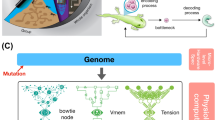Abstract
This paper is part of a larger project whose main objective is to demonstrate experimentally that the following hypothesis holds: computational developmental systems on a cellular structure are a) naturally fault-tolerant and b) evolvable. By naturally we mean that the system is not fault-tolerant by explicit design nor due to evolutionary pressure, but rather that the framework insures a high probability of fault-tolerance as an emergent property. In this paper, we propose to study the self-repair capacities of a specific developmental cellular system introduced in [13]. More specifically we compare the toroidal and the non-toroidal cases. Their evolvability is to be presented in details in a further article. All the examples studied here have been evolved to configure an abstract digital circuit. The evolved organisms are subjected to a series of different fault models and their self-repair abilities are reported. From the results exposed here, it can be concluded that, while not systematic, perfect self-repair, and hence fault-tolerance is a highly probable property of these organisms and that many of them even exhibit fully perfect self-repair behaviour under all tests performed.
Preview
Unable to display preview. Download preview PDF.
Similar content being viewed by others
References
Basanta, D., Miodownik, M., Bentley, P.J., Holm, E.: Evolving and growing microstructures of using biologically inspired ca. In: 2004 NASA/DoD Conference on Evolvable Hardware, pp. 275–282. IEEE Comput. Soc., Los Alamitos (2004)
Hogeweg, P.: Shapes in the shadow: evolutionary dynamics of morphogenesis. Artificial Life 6(1), 85–101 (2000)
Kim, J.: Transsys: a generic formalism for modelling regulatory networks in morphogenesis. In: Kelemen, J., Sosík, P. (eds.) ECAL 2001. LNCS (LNAI), vol. 2159, pp. 242–251. Springer, Heidelberg (2001)
Kniemeyer, O., Buck-Sorlin, G., Kurth, W.: A graph grammar approach to artificial life. Artificial Life 10(4), 413–431 (2004)
Leung, C., Berzins, M.: A computational model for organism growth based on surface mesh generation. Journal of Computational Physics 188(1), 75–99 (2003)
Liu, H., Miller, J., Tyrell, A.: An intrinsic robust transient fault-tolerant developmental system. In: Workshop on Regenerationand Learning in Developmental Systems, GECCO 2004 (2004)
Macias, N.J., Durbeck, L.K.: Self-assembling circuits with autonomous fault handling. In: Stoica, A., Lohn, J., Katz, R., Keymeulen, D., Zebulum, R.S. (eds.) Proceedings of the 2002 NASA/DoD Conference on Evolvable Hardware, pp. 46–55 (2002)
Mange, D., Sipper, M., Stauffer, A., Tempesti, G.: Towards robust integrated circuits: The embryonics approach. Proceedings of the IEEE 88(4), 516–541 (2000)
Miller, J., Thompson, P.: Beyond the complexity ceiling, evolution, emergence and regeneration. In: Workshop on Regenerationand Learning in Developmental Systems, GECCO 2004 (2004)
Miller, J.F.: Evolving developmental programs for adaptation, morphogenesis, and self-repair. In: Banzhaf, W., et al. (eds.) ECAL 2003. LNCS (LNAI), vol. 2801, pp. 256–265. Springer, Heidelberg (2003)
Miller, J.F., Hartmann, M.: Untidy evolution: evolving messy gates for fault-tolerance. In: Liu, Y., Tanaka, K., Iwata, M., Higuchi, T. (eds.) ICES 2001. LNCS, vol. 2210, pp. 14–25. Springer, Heidelberg (2002)
Miller, J.F., Thompson, P.: Cartesian genetic programming. In: Poli, R., Banzhaf, W., Langdon, W.B., Miller, J., Nordin, P., Fogarty, T.C. (eds.) EuroGP 2000. LNCS, vol. 1802, pp. 121–132. Springer, Heidelberg (2000)
Ozturkeri, C., Capcarrere, M.S.: Emergent robustness and self-repair through developmental cellular systems. In: Ninth International Conference on the Simulation and Synthesis of Living Systems (ALIFE9), pp. 21–26. MIT Press, Cambridge (2004)
Pfeifer, R.: Interacting with the real world: design principles for intelligent systems. In: Ninth International Symposium on Artificial Life and Robotics (AROB 9th 2004), vol. 1, pp. 13–18. Oita University (2004)
Righetti, L., Shokur, S., Capcarrère, M.S.: Evolution of fault-tolerant self-replicating structures. In: Banzhaf, W., et al. (eds.) ECAL 2003. LNCS (LNAI), vol. 2801, pp. 278–288. Springer, Heidelberg (2003)
Roggen, D., Federici, D.: Multi-cellular development: Is there scalability and robustness to gain? In: Yao, X., Burke, E.K., Lozano, J.A., Smith, J., Merelo-Guervós, J.J., Bullinaria, J.A., Rowe, J.E., Tiňo, P., Kabán, A., Schwefel, H.-P. (eds.) PPSN 2004. LNCS, vol. 3242, pp. 391–400. Springer, Heidelberg (2004)
Stanley, K., Miikkulainen, R.: A taxonomy for artificial embryogeny. Artificial Life 9(2), 93–130 (2003)
Streichert, F., Spieth, C., Ulmer, H., Zell, A.: Evolving the ability of limited growth and self-repair for artificial embryos. In: Banzhaf, W., Ziegler, J., Christaller, T., Dittrich, P., Kim, J.T. (eds.) ECAL 2003. LNCS (LNAI), vol. 2801, pp. 289–298. Springer, Heidelberg (2003)
van Remortel, P., Manderick, B., Lenaerts, T.: Gene interaction and modularisation in a model for gene-regulated development. In: 2004 NASA/DoD Conference on Evolvable Hardware, pp. 253–260. IEEE Comput. Soc., Los Alamitos (2004)
Wolpert, L., Beddington, R., Jessell, T., Lawrence, P., Meyerowitz, E., Smith, J.: Principles of Development, 2nd edn. Oxford University Press, Oxford (2002)
Author information
Authors and Affiliations
Editor information
Editors and Affiliations
Rights and permissions
Copyright information
© 2005 Springer-Verlag Berlin Heidelberg
About this paper
Cite this paper
Öztürkeri, C., Capcarrere, M.S. (2005). Self-repair Ability of a Toroidal and Non-toroidal Cellular Developmental Model. In: Capcarrère, M.S., Freitas, A.A., Bentley, P.J., Johnson, C.G., Timmis, J. (eds) Advances in Artificial Life. ECAL 2005. Lecture Notes in Computer Science(), vol 3630. Springer, Berlin, Heidelberg. https://doi.org/10.1007/11553090_15
Download citation
DOI: https://doi.org/10.1007/11553090_15
Publisher Name: Springer, Berlin, Heidelberg
Print ISBN: 978-3-540-28848-0
Online ISBN: 978-3-540-31816-3
eBook Packages: Computer ScienceComputer Science (R0)




